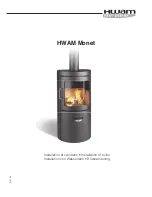
96
Part 1 - General Safety Information
Part 15 - Maintenance Report
INSPECTION ACTIVITIES
DATE LAST COMPLETED
PIPING
1st YEAR 2nd YEAR 3rd YEAR 4th YEAR*
Near boiler piping
Check boiler and system piping for any sign of leakage. Leaking pipes could
cause property damage. Make sure all piping is properly supported. See
User’s Information manual for instructions.
Vent
Check condition of all vent pipes and joints. Ensure all vent piping is properly
supported. Check for obstructions at exhaust and intake termination points.
Gas
Check Gas piping, test for leaks and signs of aging. Make sure all pipes are
properly supported.
SYSTEM
Visual
Do a full visual inspection of all system components.
Functional
Test all functions of the system (central heat, water heating, Safeties)
Temperatures
Verify safe settings on boiler or Anti-Scald Valve
Temperatures
Verify programmed temperature settings
ELECTRICAL
Connections
Check wire connections. Make sure they are tight.
Smoke and CO
detector
Verify devices are installed and working properly. Change batteries if
necessary.
Circuit Breakers
Ensure the circuit breaker is clearly labeled. Exercise circuit breaker.
Switch and Plug
Verify ON/OFF switch and convenience plug are both functional
CHAMBER/BURNER
Combustion Chamber Check burner tube and combustion chamber coils. Clean according to
maintenance section of manual. Vacuum combustion chamber.
Spark Electrode
Clean. Set gap at 1/8”.
CONDENSATE
Condensate Trap
Clean debris from the condensate trap. Fill with clean water.
Neutralizer
Check condensate neutralizer. Replace if necessary.
Condensate hose
Disconnect condensate hose. Clean out dirt and re-install. (
NOTE:
Verify the
flow of condensate, making sure that the hose is properly connected during
final inspection.)
GAS
Pressure
Measure incoming gas pressure (3.5 to 10.5” W.C. NG, 8 to 13” W.C. LP)
Pressure Drop
Measure drop in pressure on light off (no more than 1” W.C.)
Check for leaks
Check gas piping for leaks. Verify that all are properly supported.
COMBUSTION
CO/CO2 Levels
Check CO and CO2 levels in Exhaust. Record at high and low fire.
SAFETIES
ECO (Energy Cut Out)
Check continuity on flue temperature sensor. Replace the flue gas temperature
sensor if corroded.
Check continuity on Water ECO. Check position and sensor resistance.
Ensure air pressure switch is properly connected (electrical connections and silicone
pipe).
DHW LOOP - Combi Models
It is recommended to flush the DHW heat exchanger annually if water
hardness exceeds 12 grains per gallon (considered extremely hard water). If
water hardness falls below 12 grains per gallon it is recommended to flush
the heat exchanger every two to three years.
It is also recommended to clean the CH and DHW inlet filters annually.
FINAL INSPECTION
Check list
Verify that you have completed entire check list. WARNING: FAILURE TO DO
SO COULD RESULT IN SERIOUS INJURY OR DEATH.
Homeowner
Review what you have done with the homeowner.
TECH SIGN OFF
Table 35 - *Continue annual maintenance beyond the 4th year as required.
Содержание FTVN
Страница 98: ...98 Maintenance Notes...





































